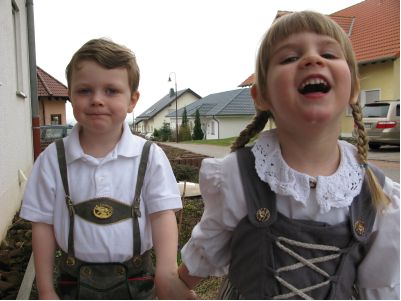
[Update: 2009 Walsh Laboratory analyzed the MRI and said it was Perisylvian Syndrome. Waiting on Dr. Dobyn’s review.]
As with most diagnosis, you put the pieces together later. Our daughter Jenna was diagnosed with Pachygyria and LIS in May 2008 after many tests. I want to share what we saw in the beginning and how things developed over time.
We had Jenna from day 10 of her life and she was legally adopted when she was 6 weeks old. The birthmother was 19 years, had one child at 16 (that her parents were raising) and did not have any prenatal care (said she did not know she was pregnant until 1 week before delivery). She smoked 2 packs of cigarettes a day and likely there was some drinking and partying going on.
She had normal birth weight (6lbs 6 oz, 19 inches) and APGAR scores. The thing we noticed right away was her abnormal sucking pattern—people would think she was starving because she sucked so loud and hard. She looked like a “Buddha baby” with large fat rolls all over.
The Pediatrician also noted she held her thumbs inward and said that usually was a sign of neurological issues, but not to worry. By the time she was 5 months old we had her evaluated by a Physical Therapist. She was found to have a mild right Torticollis and slight fine and gross motor delays. She drooled a lot, but since she was the 1st child we thought she was teething and it was normal. We saw a Physical Therapist for a few months to help her open her fists when crawling (Amy style).
She took her first step around 1 year but she couldn’t say Mama and her profound drooling continued. She was always smiling and friendly and cute, so we didn’t think anything was too wrong. At 1 ½ years I began to be concerned about her lack of speech so I took her for an evaluation by a Developmental Pediatrician. They did see delays and low muscle tone so we were referred for speech therapy (ST) when Jenna was nearly 2 years old. We had her hearing tested (which was fine). I began teaching her sign language. We noticed sensory problems—extreme reactions to loud noises, certain textures and things going over or on her head, so we got her into a special preschool for children with delays. At 2.5 years they started Occupational therapy (OT) since there was a lot of problems with using her hands (she held them tight).
When Jenna was 3 she started a full day developmental preschool with ST, OT and PT during the day. She still couldn’t suck (in a straw) or blow, or say any words and drooled excessively (even though all teeth were in). Her mouth is constantly open.
At 3.5 she saw another Developmental Pediatrician (the Chief) and she noted Jenna’s strange walking/running gate, low muscle tone (she has large folds of skin around her armpits/shoulders and her tummy is like bread dough) and problems with fine motor skills and referred her to a University Clinic for a week of diagnostic testing. She wanted intense sensory feedback and would put anything into her mouth but particularly liked sand, vinegar (salad dressings) and strong sweet flavors. She couldn’t chew and would not eat meat or vegetables that weren’t really soft. She mainly wants creamy things like yogurt and cheese. She was communicating fairly well using sign language, gestures and babbling (can say vowel sounds). We let her continue to have a pacifier hoping it would help her to learn to close her mouth and suck, but the dentist eventually advised against it and we had her give it up when she just turned 4 years.
In May 2008 she had an abnormal EEG, and her MRI images showed there were 3 regions in the brain that had pachygyria (where the gyria are flat and wide).

Her hearing, heart, eyes and labs were all normal. She had another abnormal EEG (sleep) but no signs of epileptic seizures. Her blood work was sent for DNA and Chromosomal testing to rule out LIS1 and LISX1, FragileX Syndrome. At that time her urine for sent for metabolic testing (CDG, Caritin, As VLCFA). These tests came back normal. Jenna had another abnormal EEG in Nov 2008.

In between all this there was a lot of waiting for appointments (that seemed far to far away) and wondering what Jenna’s life will be like. No one can say. The Pediatric Neurologist was very sensitive when he told us. He said he has only seen children will full pachygyria and they are not able to function independently, so Jenna is very fortunate. He told us that you never know how the brain can compensate in another part, so she may be able to still overcome some of the difficulties. He said she will develop epilepsy, it is just a matter of time (since the electrical system is affected by the pachygyria) and she does have mental retardation (how much we don’t know).
In April 2009 (she will be 5 in May) she is able to hold a pencil/marker and make shaky circles and hen scratch. She still has a lot of trouble grabbing things with a pincher grasp and will generally “rake” things or knocks things over as she tries to get them. She drools still but we have moved to kerchiefs (since they aren’t so baby looking as bibs). She will swallow when we tell her or wipe the drool away when asked, but does not get the sensory feedback on that. She still sits in a high chair with a plastic bib that has a lip on it to catch food and drink. She can drink from a cup if there isn’t too much in it; otherwise most of it comes out the sides of her mouth because she can’t swallow it properly. Her tongue won’t move food to the teeth so she puts her fingers in her mouth to move it (eating is usually pretty messy, also because she likes the sensory touch of food). Jenna is not potty trained. We think it may be like the drooling—that she doesn’t get sensory feedback to her brain and she doesn’t know when she needs to go. If we put her on a schedule she will pee in the toilet. The poop scares her and she has yet to do that (she wears pull-ups and diapers still). Her gross motor is affected too—she waddle runs and when she jumps she must pump her arms to get momentum. She can peddle a tricycle really well and enjoys bikes with training wheels. Her speech is probably the most affected by the pachygyria. She can say vowel sounds and a few consonants (like /m/s/ but has trouble with complete words. She makes the right intonations and syllables, but uses her vowel sounds. She still mainly uses sign language, gestures and her picture boards now. She is a strong willed girl and keeps pushing on, until people understand her. She is prone to melt downs, tantrums and defiance. I chalk most of that up to the frustration of not being able to control her body the way she wants. We love her and hope that she can learn to have a more normal life, but only time will tell.
Please feel free to contact me with question or in need of support
Krista doublemomATgmailDOTcom



